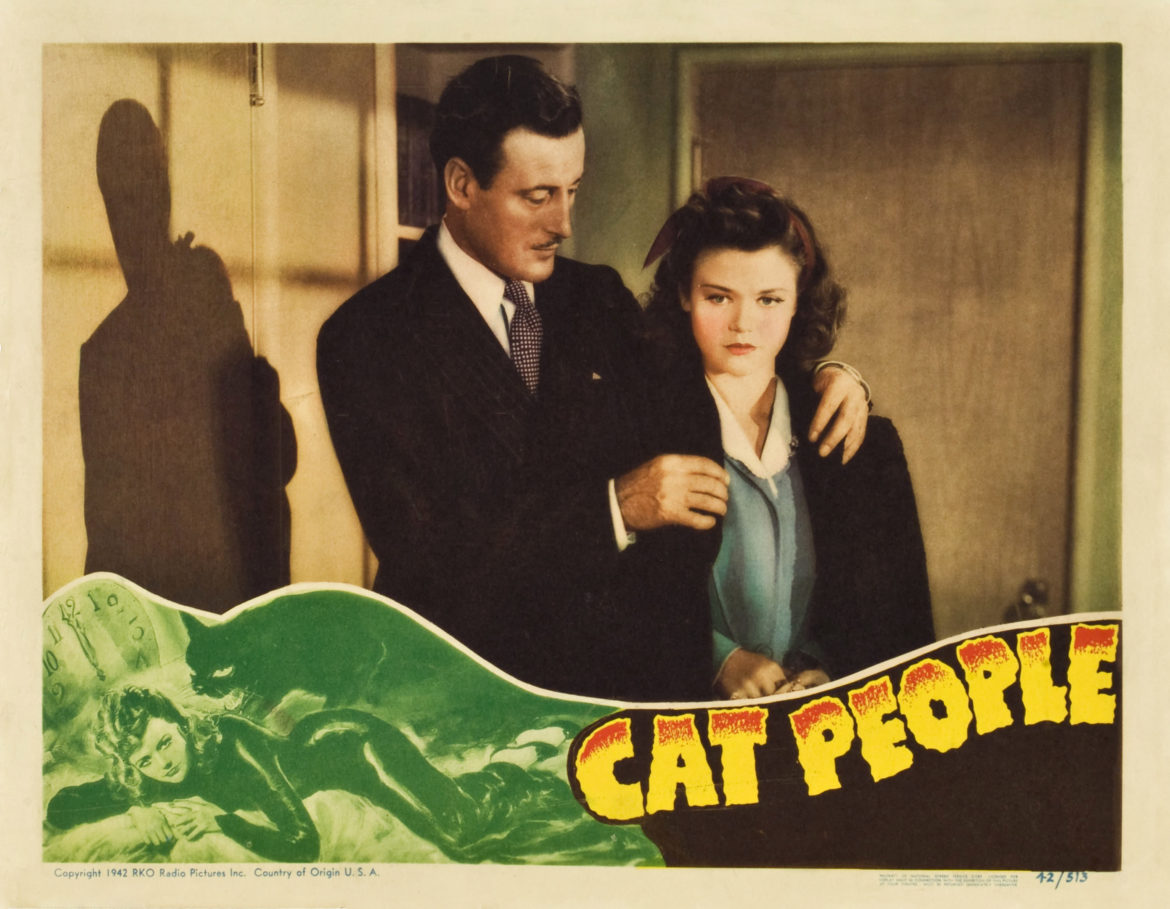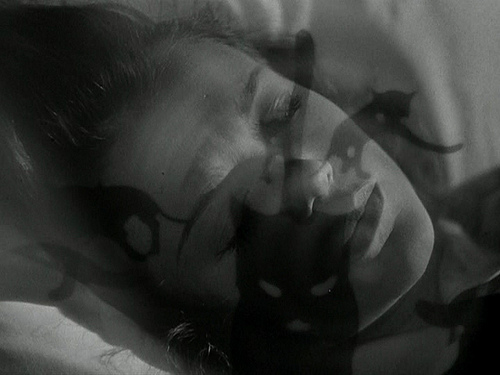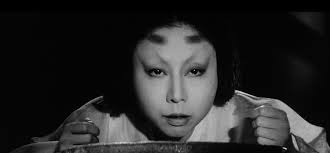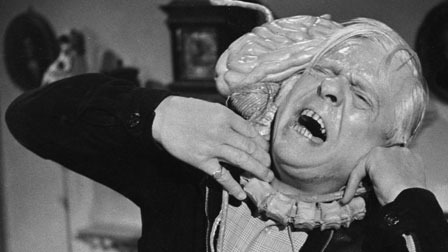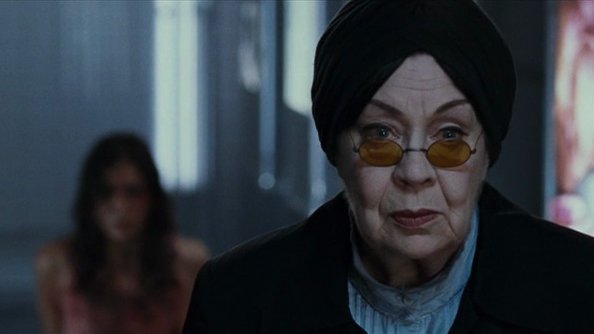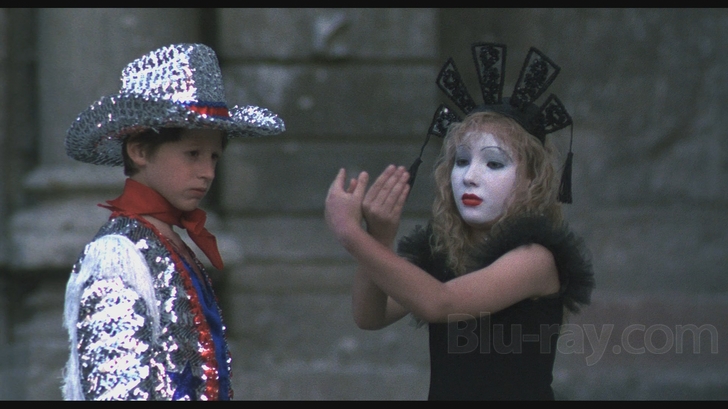Ok, it is less impressive and thematically appropriate than “31 Horror Movies For October,” but that’s how it ended up.
What can I say? Life gets in the way, your stolen internet goes dark, you leave town for a few days, no one wants to watch horror movies at a wedding – many things can happen. On the other hand, 26 seems like a decent effort to me, so I don’t feel too ashamed.
These were all first views for me, or at least first intentional views as an adult – I’m pretty sure I’d already seen Frankenstein, for instance, but it’s hard to tell: the imagery is so iconic that it’s almost like a childhood vacation you aren’t sure you really remember, rather than simply the pictures of it on your parent’s mantel. In any case, the whole point was to watch horror movies I hadn’t seen, or at least hadn’t watched. (Write-ups added as I get to them.)
1. Cat People, 1942
2. The Curse of the Cat People, 1944
3. The 7th Victim, 1943
Val Lewton’s production trifecta is described at length here. Expansive shadows and contrasts, sublimated desire, impossible lovers, surprising bus arrivals, children who know better than the adults around them what’s up, conspiracy, walls closing in, mysterious absence of titular cat people – basically, the blueprint for a certain kind (editor’s note: the best kind) of American cinematic horror, and one which will show up again in this list. These are amazing films and we should all go watch them; their influence is undeniable, and not just in horror. Anywhere some cash-starved filmmaker is generating tension with shadows and the unseen, Lewton’s RKO movies are lurking in the background.
4. Kuroneko, 1968
5. Onibaba, 1964
Kuroneko, a Japanese masterpiece discussed in detail here, is one of the more beautiful films I saw this month: an angry, anti-authoritarian vision that hearkens back to classic forms while anticipating contemporary revenge narratives. Spoiler: It has more cat people than Cat People.
Onibaba, director Kaneto Shindo’s previous treatment of the same myth, is an altogether different picture. Unabashedly, genuinely sexy, and filled with arthouse details like long shots of swaying reeds and nature in tumult, it is less concerned with state politics than the body politic, in the most literal sense. Kuroneko is far and away the more impressive film, but Onibaba is notable for its frankness if nothing else, and the performances are stellar and brave. Also, that mask is creepy.
Mario Bava’s proto-slasher flick. It’s … eh, well. There are the occasional half-naked ladies (if that’s your thing, weirdo), and at one point two idiots get simultaneously speared while boning, so it has that going for it.
7. Frankenstein, 1931
8. The Bride of Frankenstein, 1935
There are few more iconic images in cinema than Frankenstein rising from the operating table or, in its sequel, his bride standing straight and horrified, with the lightning shock of white through her towering hair. In fact, they might be so iconic that no one watches the movies anymore – we already know what happens. Specifically, Frankenstein rises from an operating table, and his bride has crazy hair. Done and done.
I made sure to include these in the list because I honestly can’t remember if I ever watched them from start to finish. They both played on regular rotation on television throughout my childhood – Sundays, Channel 20, in the afternoon, along with westerns and a grab-bag of other old films the network had been able to grab cheaply, one presumes. I remembered them like dreams, or like pictures I saw on someone else’s mantel, in a house I haven’t been to in a while.
Watching them now, I learned a few things: 1) Bride is significantly funnier and better than the first one; 2) Director James Whale did a fairly honest transposition of Mary Shelley’s novel, making the monster more a tragic than a diabolical figure; and 3) even from the start, horror movies have been intensely concerned about gender, identity, and transformation.
Bride of Frankenstein significantly improves on the rather by-the-numbers adaptation of Frankenstein. To its credit, it attributes the story to “Mary Wollstonecraft Shelley;” in the original, it says it’s based off a tale from “Mrs. Percy Shelley,” which is fucked on a number of levels. That’s not the only nod towards feminism in the film (not to mention basic decency), but it’s comforting to see it on the screen first thing.
There’s not much to talk about in the story – Frankenstein’s monster desires a companion, his creator wants nothing to do with it thanks to the earlier murders, a mad scientist is only too happy to help – but it’s a structural masterpiece (built around Mary Shelley, slyly knitting before a fire, telling Lord Byron and her husband the rest of the story, which she says she hadn’t yet published), and the script gives everyone plenty of room to breathe. It’s far less stilted than the original: the monster’s efforts to gain language are funny, his failures to communicate are poignant, and the transformation scene at the end deserves every bit of its fame.
Whale, an openly gay man in early Hollywood (and so something of a rarity), made these classics of misunderstood outsiders, inherently suspected “deviants” rejected and misunderstood by mainstream society, who piece together identities, struggle to define themselves, and long for community in a hostile world. Throughout the month, the movies I watched kept coming back to these themes, in overt and oblique ways. Horror – located in the body, seeking to generate visceral thrill, concerned above all with flesh, its vulnerability and capacity for transformation – lends itself particularly well to symbolic treatments of questions of identity and sexuality. In Frankenstein and especially The Bride of Frankenstein, these questions bounce around without being answered, but both films make a wise decision: they treat them in passing, and focus on presenting something new and fun and relatable and scary. The themes are so crucial to the genre that they don’t need to be underlined – they’ll always be there. We couldn’t avoid desire if we wanted to.
9. A Nightmare on Elm Street Part 2: Freddy’s Revenge, 1985
A commenter on The Dissolve introduced me to the notion of the “perpendicular sequel” – a film that draws from but doesn’t interfere with the original, and launches off in a different direction. If ever there were a movie that fits the bill, it’s A Nightmare on Elm Street 2: Freddy’s Revenge.
For one thing, Freddy Kreuger, the child-killing villain from the first film who showed up in the dreams of the town’s youngsters to exact revenge for his own murder, is no longer interested in terrorizing all of them – he now haunts one boy alone. That boy, Jesse, is tormented by him, and it becomes clear that Freddy is some kind of manifestation of Jesse’s own turmoil. Sure, Jesse moved into the house across the street from where we watched another boy die in the first film, but there are other traumas at play.
This is a huge departure from the mythology that launched the series, not but one installment ago. It’s actually kind of amazing that this movie ever got made at all: Most direct sequels stick to at least the bare-bones structure of their predecessor. Not so here: Freddy’s revenge, such as it is, lands directly on poor Jesse, who is left to grapple with a whole host of identity issues, given that Freddy has now decided to literally live inside him. He’s a dark, threatening aspect of Jesse’s psyche (and, apparently, stomach), which must be repressed if Jesse’s going to fit in at school, get a girl, live a happy suburban life.
Some people say that this is the out-and-out gayest film of the franchise, possibly of all horror movie franchise entries in history. Those people are right. You would have to be willfully, steadfastly opposed to the obvious to ignore it.
This is a movie in which the gym coach frequents leather bars (or “S&M joints,” according to one character, who is made to do punishing laps and push-ups for the coach’s amusement – “That’s just how he gets his rocks off,” he points out; later, the same character mentions to Jesse that the coach “likes pretty boys like you”). Later, the coach is flayed to death with jump ropes in the school shower, naked and bound, after tennis ball canisters aggressively ejaculate in all directions. This is a movie where our protagonist runs away from the female love interest to hide out in his buddy’s bedroom, who incredulously, mockingly notes, “There’s a girl waiting for you and you want to spend the night with me.” This is a slasher movie in which only men die – is it the only one where this is true? – and, notably, only those men who embody either danger or desire for our Jesse. In case things weren’t clear enough for the audience, the filmmakers helpfully add this: As Freddy fights his way out of Jesse’s stomach (in one of the genuinely gross, fun scares in a movie that seems to have forgotten it’s supposed to include those at all), Jesse mournfully cries out, “He’s INSIDE ME, and he WANTS TO TAKE ME AGAIN.”
It’s all incredibly amusing and campy, actually, but the plot beats could be read in a deeply homophobic way. Does Jesse triumph over carnal desire by eliminating the boys he might kind of want to bang, and secure redemption from his terrible, terrible urges with the help of Lisa, who would in any other horror movie be the Final Girl? (Here, she’s simply a calm port in the storm, a promise of normalcy, and a possible salvation from Freddy’s torment.) Or, as Freddy cackles at him in the end, driving back into the desert where the movie began, has Jesse just postponed dealing with the embodiment of a power that can’t be willed away so easily?
Is this taking A Nightmare on Elm Street 2: Freddy’s Revenge a little too seriously? In a word, yes. But the film, like a lot of modern American horror, is a mythic treatment of adolescent confusion, played out for giggles and scares. It also has absolutely nothing to do with the A Nightmare on Elm Street series, and is sort of lovable for that reason alone. (Not to mention Jesse’s sweet dance moves.)
One thing is clear: there aren’t too many movies like it. And given the vehement, bordering on disgusted, rejection of it by the series’ fan base – who were decidedly less interested in a protagonist grappling with his sexuality than people being cut up with razor fingers or drowned in water beds – there probably won’t be another.
10. Fiend Without A Face, 1958
Atomic reactors! Radiation and mysterious crop failures! A secret joint U.S.-Canadian nuclear operation aimed at the Russians!
Fiend Without A Face is definitely a Cold War artifact, and laughably silly more often than not, but it’s also really well made and engaging. It touches on public fears which haven’t gone away, though the details have changed, and includes an admirable number of viewpoints without belittling them.
It also features sometimes-invisible monsters made of brains and spinal cords, who strangle you and suck out your essence to live. Which is awesome.
The film concludes with an old-fashioned shoot-out – basically, a brain massacre – and the props leak what appears to be grape jam.
I enjoyed this movie.
Martyrs is not a good movie.
No, I will go further: Martyrs is a bad movie, born of false pretense, disingenuously presented, and executed poorly. It is the only movie on this list I outright disliked. It wouldn’t be so bad if it didn’t think it was so smart. It is not smart. It’s a stupid exercise foisted on the gullible for shitty reasons.
Here is the basic plot: A shadowy cabal kidnaps women to torture them into a state of grace, what they refer to as “martyrdom.” One can tell the martyred by the hollow look in their eyes as they stare to the Heavens, having emptied themselves of all hope. This cult wants to create a martyr and keep her alive long enough to relate what she sees before she dies. (It’s always a “she,” we’re told: women are somehow more inclined to grace through suffering. Why? Who knows, let’s keep this shitshow moving along.)
We’re introduced to these nice folks by way of an actually scary plotline involving a tortured child who escapes, but we only find out what it was about later. In the early scenes, the movie is filled with promise: is there anything scarier than a wounded child running away from some unknown horror house? I vote no. And right up until the middle of the movie, Martyrs is scary.
When we discover the plot underlying everything, the movie caves in on itself, in the most despicable possible ways. Scene after scene simply repeats itself: A ladder descends to an industrial basement. Our protagonist, now grown, is tied up and beaten. Dissolve. Our protagonist pisses herself. Dissolve. A ladder descends. Our protagonist is beaten for a while. Dissolve. A ladder descends. Our protagonist’s head is sheared, painfully. Dissolve. I think this continues for several hours, though that seems impossible given the movie’s alleged running time.
Its intentionally punishing in its aesthetic, and we’re implicated as viewers. The film desperately wants to be called “extreme cinema,” and get both arthouse and Fangoria points for being “willing to go there.” What is it actually? It is 30 minutes of a woman being punched in the head, then skinned alive, with some half-assed pseudo-science and a cop-out ending.
There’s nothing there; the profound eschatological inquiry is just a cover, like we knew it was from the start. This is a movie about, above all else, a woman getting punched in the face, and us watching her get punched in the face.
I’m not squeamish about these things in movies. There is violence in the world, and movies are part of the world. It’s not even the nature of the violence, or its targets, that bothered me here: it’s the idea that we would learn something, or feel something, when the movie has absolutely no interest in teaching or imparting feeling. Its producers and directors know there is a built-in audience for literally anything violent and over-the-top, but they aren’t content with exploitation. They mean to make art.
They fail at that, and at many other things. In the end, the movie they made is a nasty, mean-spirited fraud.
Alejandro Jodorwosky’s Santa Sangre – a “horror” movie steeped in ritual, wacked-out symbolism, and the surreal – achieved what no other movie could: it made me enjoy an Alejandro Jodorowsky film.
I have tried and tried to like his earlier films. I am told, on good authority, I really should. They are midnight-movie staples which helped define the notion of the midnight movie and clearly important, singular, weird, maybe visionary … but they leave me cold.
I recognize their crazed passion, but what can I say? El Topo, with its ponderous long shots and elaborate set pieces and kind of half-baked shamanism and ludicrousness, and The Holy Mountain’s ostentatious framing and inscrutable cosmology … they come across to me as Hippie Cinema By Way Of Bunuel, at its most desperate. Watching them, I just feel each time like I showed up at a party where everyone dropped acid two hours ago, and they ran out. It’s amusing enough to look at, but I probably should just go to a bar.
Santa Sangre is different, and not just because decades have passed.
Where El Topo and The Holy Mountain operate in a genre netherworld – mostly constructed around naked people offering words of wisdom and dread, in between shots of the sun – Santa Sangre felt actually rooted somewhere (ironically, in a traveling circus, a fantastic image of rootlessness).
It has characters we care about – the woman defending her people’s church, the boy born into this life who longs for something and someone else, the girl who longs for him, the elephant who can’t stop bleeding and whose closed-casket funeral procession is the most striking image in the whole movie.
Yes, the elephant funeral, with its Fellini-esque march of musicians, clowns, knife-wielding womanizers, heretical priestesses, and child-magicians. Don’t worry: This is still an Alejandro Jodorowsky film.
But it’s a Jodorowsky horror, and maybe the genre aspect is what I found appealing. It’s a ghost story, really.
The young boy, Fenix, is a sham magician in his parent’s operation, learning artifice as the family trade. A series of unfortunate events leave both his parents dead – his mom, with her arms cut off like the saint she worships; his dad, who slits his own throat after getting his genitals burned off with acid in retribution for infidelity. Life is hard in this circus.
Fenix grows up, and not very gracefully. When we meet him again, he’s escaping from some sort of mental health facility where he was being held (a progressive one: the proprietors were kind enough to install a tree inside so he can pretend to be a bird, as is his wont). Beckoned by his mother, now apparently corporeal, he ascends the tree and makes a break for it.
Fenix then finds himself back on the sideshow beat, with his main act being a pantomime with his ghost-mom, where he uses his arms in place of hers on stage. They have a good thing going, but the girl he loved so long ago (presumably not a ghost) has also been looking for him. It’s clear nothing good is going to come from any of this.
The things that have and continue to bug me about Jodorowsky are still here in Santa Sangre: the on-the-nose symbolism, the extravagant set pieces, the uncanny shenanigans that almost seem like they should come with a footnote in a corner of the screen, referencing other symbolic art you might enjoy.
But in a horror context, it works: I had no trouble believing that things would spiral this out of control, or that the surrealist touches would be there. It rarely felt forced – the basic notion, that the madness of the unconscious can be let loose at any minute and we’d be fools to even wonder at it, makes much more sense here. And in its closing moments at least, it’s legitimately scary.
He constructs striking images; that much is not in dispute. Even in the early films I’m sort of deriding, I recognize this is true. In some ways, I think he prefers images alone, rather than stringing them together to make a film. Jodorowsky’s Dune, the documentary about his failed attempt to adapt Frank Herbert’s sci-fi novel, might hint at his true position: he sure does love talking through the movie from illustrated stills. It almost seems like it doesn’t matter to him that it didn’t pan out.
But in Santa Sangre, it all works – image, mood, ritual. It’s a great film, worthy of his visual genius.
13. The Masque of the Red Death, 1964
14. God Told Me To, 1976
15. Sleepaway Camp, 1983
16. The Conjuring, 2013
17. Orphan, 2009
18. Vampyr, 1932
19. Sisters, 1973
20. Eyes Without A Face, 1960
21. Dead Snow 2, 2014
22. Peeping Tom, 1960
23. Trouble Every Day, 2001
24. The Haunting, 1963
25. An American Werewolf in London, 1981
26. The Wolf Man, 1941

